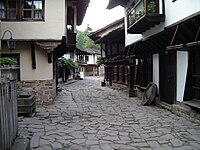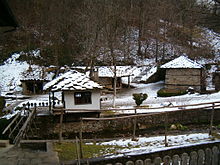Etar open-air museum
 Commercial street |
|
| Data | |
|---|---|
| place | Gabrovo |
| Art |
open air museum
|
| opening | Founded in 1964 |
| Website | |
The open-air museum "Etar" ( Bulgarian Архитектурно-етнографски комплекс "Етър" / Architekturno-etnografski kompleks "Etar"; German as: "Etar" Architectural ethnographic complex) is an open-air museum in Bulgaria , 8 km south of the center of Gabrovo , in the same Gabrovo district of Etara. Etar (Bulgarian Етър) is the old name of the river Jantra , on the upper reaches of the Jantra, where Gabrovo and the open-air museum are located, it is often referred to by its old name.
The museum is the only open-air museum in Bulgaria, is located on the edge of the "Balgarka" nature park , about halfway between the park boundary and the city of Gabrovo and is one of the 100 national tourist objects in the country listed by the Bulgarian Tourism Association . The museum shows everyday Bulgarian life, culture and old traditional handicrafts, as well as Bulgarian architecture from around 300 to 150 years ago.
history
The museum aims to preserve popular Bulgarian traditions and was built from 1963 under the direction of Lasar Donkow and opened on September 7, 1964. The Karadschejka watermill from 1780, which was preserved in situ , was extensively renovated for this purpose and supplemented with other buildings, some of which were originally brought from other locations and some of them are replicas that are true to the original. It has had the status of a national monument since 1971.
description
The museum extends over 7 hectares and houses 50 objects. In addition to farms and craftsmen's houses, these are outbuildings, wells, bridges, ovens, a church with a school, a clock tower and a mosaic wall. The houses are from the time of the Bulgarian Revival , in the typical style of Bulgarian Revival architecture : they are two-story and typically have many windows, bay windows with carved wooden beams and wooden balconies. Fifteen reconstructed houses of this type form the so-called "commercial street".
A special feature of the museum is the collection of various types of water-powered technical systems, which is unique in Bulgaria and includes a total of 10 fully functional objects. These include a grain mill and a fulling mill , a sawmill , a trimming weaving mill and turning workshops for the production of wooden bowls and wooden wine bottles. All systems are functional and can also be put into operation thanks to a two-stage channel system.
In the houses of a number of workshops for artisans are established in which 20 traditional handicrafts are shown: one workshop for a coppersmith and a potter , for woodcarving , icon painting , a wheelwright shop , furrier workshop , a silversmith , workshops for goatskin processing, for making of folk musical instruments , a cutlery , a saddlery , weaving mill , sugar workshop, a bakery and a bell smithy.
There is a hotel, two restaurants and a café on the museum grounds.
Changing special exhibitions are shown throughout the year. Especially in the summer months there are several special events on festive days with the presentation of Bulgarian customs and folklore programs.
Especially in winter, courses of several days on various traditional craft techniques are offered. The spectrum is based on the existing workshops and ranges from icon painting to weaving and plaiting to the craft of furriers. At the beginning of September there is an international craft fair with many cultural events.
Events and offers
Many special events and courses take place within the museum complex. The museum operates an elaborate, four-language website with many videos.
See also
- List of European open air museums
- Sokolski Monastery (located 2 km southwest of the museum)
Remarks
- ↑ It might be more correct to use the term ethnological instead of ethnographic . A corresponding museum in Berlin is also called the Ethnological Museum . Such museums often have the term ethnology in their German name as a synonym for ethnology . However, at the Museum für Völkerkunde zu Leipzig , for example, one speaks of the ethnographic collection , as does the State Ethnographic Collections of Saxony in Dresden. In contrast, the ethnological collection of the University of Göttingen uses ethnological instead of ethnographic . The Polish Ethnographic Open-Air Museum in Zielona Góra has the term ethnographic ( Muzeum Etonograficzne ) in its Polish name , as do the ethnographic museums in Budapest , Stockholm , Ankara and many open-air museums in Russia and Eastern Europe.
-
↑ The Etara district (bulg. Етърa ) is only used with the definite article, an appended a "-a" after Etar . In contrast, the name of the museum is preferably used without this specific article, hence the “Etara” district but the “Etar” open-air museum . Occasionally, however, the museum is also referred to as the “Etara” open-air museum (with “-a”).
The Etara district is actually more of a settlement 8 km outside of Gabrovo.
Web links
- Museum website (also in German)
- Artisans at work in the Etar open-air museum: [1] , [2] , [3] , [4] (wickerwork from corn stalks) (YouTube films)
Coordinates: 42 ° 48 ′ 18 ″ N , 25 ° 20 ′ 55 ″ E



